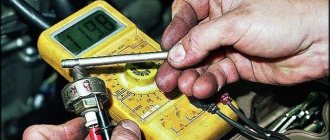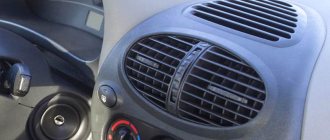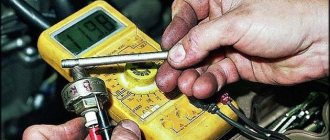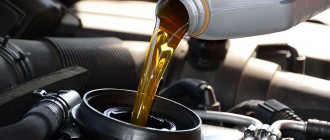Of course, Russia, over its more than thousand-year history, has enough examples for well-deserved pride. However, the auto industry is clearly not one of them.
Lada Priora is considered one of the most controversial achievements of the automotive industry of the Russian Federation. On the one hand, it was well received both by customers, as evidenced by excellent sales at the time of release, and by representatives of the automotive press. On the other hand, the joy of the owners knew no bounds only because of the relatively low cost of this vehicle. As soon as all its shortcomings, characteristic of most cars from the Togliatti company AvtoVAZ, were revealed, Priora began to be hurled with choice curses.
Increased fuel consumption of Priora 16 valves reasons
Nowadays, the criterion for the efficiency of a power plant is no less relevant than the number of horsepower or the time it takes to reach the first hundred. The engines of the updated VAZ line, being in good working order, fully meet modern requirements, both in terms of appetite and potential.
The average fuel consumption for a Priora 16 valves (98 hp) with manual transmission is 6.9 liters per hundred kilometers. Until recently, Priora, which was the flagship model, armed with 106 hp, was no less economical - 6.8 liters per “hundred”. Updated advanced configuration with 106 hp engine. and a five-speed automatic transmission, it has the lowest consumption in mixed mode - 6.6 liters per 100 km.
It is no secret that the most economical mode is driving on the highway at a speed of about 90 km/h. Under these conditions, the on-board computer will show the minimum figures for the current consumption per “hundred”:
- 5.5 l. – for 1.6 l variants. (98 hp + 5MT and 106 hp + 5AT);
- 5.6 l. – for configuration with a 106-horsepower engine and manual transmission.
The bustle of the city does not characterize the efficiency of any engine from the best side. However, for the flagship VAZ series, the balance of energy consumption is normal:
- 8.5 liters per “hundred” (106 hp + “automatic”);
- 8.9 liters per 100 km (106 hp);
- 9.1 l/100 km (98 hp).
Instructions for replacing the reverse control
To replace the 3X signaling device, you need to prepare a set of keys and a new device. It is better to carry out work on an overpass or pit.
To make a replacement you need to do the following:
- Turn off the power to the machine by disconnecting the negative terminal on the battery.
- Remove the protection from the engine.
- Disconnect the power cable.
- Unscrew the old signaling device.
- Installing a new device is carried out in the reverse order.
After installation, you need to check the operation of the 3X lights.
Photo gallery “Replacing the 3D signaling device”
Increased fuel consumption on Lada Priora: why?
revolutions 87 5100 98 5600 106 5800 Displacement, cm 1596 Torque, Nm revolutions 140 3800 145 4000 148 4200 Transmission Drive Front Gearbox type 5-speed manual 5-speed automatic. What you need to do to ensure that traveling in a Bavarian doesn’t break your pocket When buying an expensive, powerful car, not all future car owners think about the expenses that will have to be made often enough to keep the car running.
New model Lada Largus Cross. Reasons for discrepancies
Often the place of unwanted recharge is the fittings located on the rear side of the sound-insulating plastic motor casing with the inscription 16 VALVE. The test at 72 km/h consisted of driving the car until the gas in the tank was completely depleted, and this test showed that an open window was more economical.
| Main characteristics | ||||
| Modification | 1.6MT | 1.6 MT 98 hp | 1.6 MT 106 hp | 1.6 AMT |
| Model year | 2013 | |||
| Body type | Sedan | |||
| Number of doors, pcs. | 4 | |||
| Number of seats, pcs. | 5 | |||
| Country of assembly | Russia | |||
| Performance characteristics | ||||
| Type of gasoline | AI-95 | |||
| Acceleration time to 100 km/h, s | 12,5 | 11,5 | 11,4 | |
| Maximum speed, km/h | 176 | 183 | ||
| Consumption (urban cycle), l/100 km | 9,0 | 9,1 | 8,9 | 8,5 |
| Consumption (highway), l/100 km | 5,8 | 5,5 | 5,6 | 5,5 |
| Consumption (combined cycle), l/100 km | 7,0 | 6,9 | 6,6 | |
| Dimensions and dimensions | ||||
| Length, m | 4,350 | |||
| Width, m | 1,680 | |||
| Height, m | 1,420 | |||
| Ground clearance, m | 0,165 | |||
| Front track, m | 1,410 | |||
| Rear track, m | 1,380 | |||
| Wheelbase, m | 2,492 | |||
| Turning diameter, m | 11,6 | |||
| Volume | ||||
| Fuel tank volume, l | 43 | |||
| Engine | ||||
| Type | Petrol | |||
| Number of cylinders / Type of arrangement | 4/Inline | |||
| Power, hp/rev | 87/5100 | 98/5600 | 106/5800 | |
| Working volume, cm³ | 1596 | |||
| Torque, Nm/rev | 140/3800 | 145/4000 | 148/4200 | |
| Transmission | ||||
| Drive unit | Front | |||
| Gearbox type | 5-speed manual | 5-speed automatic | ||
Other section materials
| general description |
| Vehicle Specifications |
| Vehicle registration details |
| Location of the main components and assemblies of the car |
| Maintenance schedule |
| Fuel, lubricants and operating fluids used |
| Changing the engine oil and oil filter |
| Coolant replacement |
| Changing the gearbox oil |
| Checking and replacing the accessory drive belt on a vehicle with air conditioning |
| Checking the condition of the timing belt |
| Checking the condition of the exhaust system |
| COOLANT LEVEL DROPPING IN THE EXPANSION TANK |
| Noise in the gearbox (noise disappears when the clutch is disengaged) |
| INCREASED FUEL CONSUMPTION |
| Generator noise |
| The fuel reserve warning light is constantly on |
| Rapid tire tread wear |
| Increased brake pedal travel |
| Error codes |
| Engine VAZ-21126, VAZ-21127 |
| Removing the engine oil low pressure indicator sensor VAZ-21126, -21127 |
| Replacing the timing belt of the VAZ-21126, -21127 engine |
| Replacement of camshaft oil seals for VAZ-21126, -21127 engines |
| Removing camshafts and replacing valve lifters for VAZ-21126, -21127 engines |
| Replacing oil seals for VAZ-21126, -21127 engines |
| Replacing the front crankshaft oil seal of a VAZ-21126, -21127 engine |
| Removing the cylinder head of the VAZ-21126, -21127 engine |
| Removing the engine sump VAZ-21126, -21127 |
| Removing the oil receiver of the VAZ-21126, -21127 engine |
| Removing the oil pump of the VAZ-21126, -21127 engine |
| Dismantling the connecting rod and piston group of a VAZ-21126, -21127 engine on a car |
| Removing the supports of the power unit of the VAZ-21126, -21127 engine |
| Removal and installation of the VAZ-21126, -21127 engine |
| Disassembly and assembly of the VAZ-21126, -21127 engine |
| Engine control system VAZ-21126, VAZ-21127 |
| Engine control system VAZ-21126, VAZ-21127 - part 2 |
| Engine control system VAZ-21126, VAZ-21127 - part 3 |
| Removing relays and fuses of the VAZ-21126, -21127 engine control system |
| Removing the VAZ-21126, -21127 engine controller |
| Removing the crankshaft position sensor for the VAZ-21126, -21127 engine |
| Removing the phase sensor from the VAZ-21126, -21127 engine |
| Removing the engine mass air flow sensor 21126 |
| Removing the engine inlet air pressure and temperature sensor 21127 |
| Removing the oxygen concentration sensors for the VAZ-21126, -21127 engine |
| Removing the coolant temperature sensor for a VAZ-21126, -21127 engine |
| Removing the engine knock sensor VAZ-21126, -21127 |
| Removing the engine speed sensor VAZ-21126, -21127 |
| Removing the vehicle speed sensor for the VAZ-21126, -21127 engine |
| Removing the gas pedal module of the VAZ-21126, -21127 engine |
Total... Owner reviews
| Increased fuel consumption of the Priora 16 valves reasons - Causes of car malfunctions and their elimination Also, do not forget that the plant regulates fuel consumption indicators only when using fuel with an octane number of at least 95. To give an accurate answer, what is the average fuel consumption of the Lada Priora, you need to take into account all the factors that influence higher or lower fuel consumption. |
| Real fuel consumption on a Priora 16 valves with 98 and 106-horsepower internal combustion engines. Faults of this kind are diagnosed using special hardware and eliminated by replacing sensors with known good ones. at low pressures, 0.4 atmospheres lower than usual, rolling resistance increases and because of this, the car consumes up to 10 more gasoline, and tires wear out faster. |
- Seasonal factor. Winter roads are more difficult for a car to overcome due to reduced grip of the surface and tires.
- Driving skills and style. With intensive changes in braking and acceleration modes, fuel consumption increases significantly.
- Octane number and fuel quality. Based on the results of numerous studies, there is a clear trend towards a decrease in vehicle fuel consumption.
- Operation of various electrical equipment of a vehicle, including climate control systems. For example, a working air conditioner takes 1 additional liter of gasoline every 100 km.
- If there is a sharp jump in fuel consumption, then it is necessary to conduct a thorough diagnosis of the vehicle, since such behavior may indicate a malfunction in the power unit system .
Actual fuel consumption of a Lada Priora with a 16-valve engine and various “boxes” • The most vulnerable components are those involved in calculating the optimal mixture composition.
Removing and checking the idle air regulator
We remove the idle air control to check and replace. With the ignition off, release the latch. ...disconnect the engine management system wiring harness block from the regulator. Terminals “A”, “B”, “C” and “D” of the wiring harness block are connected, respectively, to terminals “67”, “66”, “65” and “64” of the controller. When the ignition is turned on, the voltage values (regulator control output signals) at these terminals change chaotically and therefore cannot be checked.
Using a Phillips screwdriver, unscrew the two screws securing the regulator to the throttle assembly...
...and remove the regulator from the throttle assembly socket.
The connection between the regulator and the throttle assembly is sealed with a rubber ring. Using a tester (in ohmmeter mode), we measure the resistance between the terminals of the regulator connector. For a working regulator, the resistance between terminals “A” and “B”, as well as “C” and “D” should be 40–80 ohms. Install the idle air control in the reverse order. Before installing a new regulator...
...using a caliper we check the distance between the end of the valve needle and the supporting surface of the regulator flange. The distance should be no more than 23 mm. This is necessary in order not to damage the regulator during installation - the regulator needle should not rest against the seat of the throttle assembly. It is necessary to take into account that if the specified distance for the new regulator is more than 23 mm, then it will be possible to retract the locking needle into the regulator only with the help of a special tester (at a service station). Before installing the idle air regulator, clean the valve seat, air duct and surface for the sealing ring in the throttle assembly. Apply a thin layer of engine oil to the new regulator O-ring.
The reliable carburetor engine control circuit has long been supplanted by flexible electronics. The latter consists of a control unit and sensors operating according to a specific program. This trend has made it possible to achieve an increase in power and a decrease in fuel consumption. However, with the advent of electronics, the control system has become more vulnerable to malfunctions.
Mechanics from the outback managed to reduce the fuel consumption of the Lada Priora to 3 liters
I confess honestly. I'm not much of an engineer. I like automotive history, rare domestic concepts and crash tests more than continuous digging under the hood of a car.
But I couldn’t pass by one development of three friends from the village of Torbeevo, in Mordovia. Just a few years ago, journalists from central channels filmed stories about them.
This is what their car was like This is what their car was like
Mechanics from the village became famous for being able to achieve record low fuel consumption from the “experimental” Lada Priora. An interesting engine upgrade helped.
Now I will tell you what they did. And you decide whether to believe them or not.
I won’t make my own conclusion, simply because I don’t know much about the topic and I don’t pretend to be a car designer.
Standard view of the space under the hood of a Priora Standard view of the space under the hood of a Priora
The essence of their development:
In short, the craftsmen threw the valve springs out of the engine. Instead, the entire engine operation circuit is based on permanent magnets. This move allowed not only to reduce consumption, but also to increase efficiency. In addition, the amount of horsepower has even increased.
Stills from a REN-TV story Stills from a REN-TV story
When this idea first occurred to the comrades, they turned to AvtoVAZ. There they were assured that the Priora on magnets would not be able to work for even half an hour.
The village inventors did not listen and decided to try. If you believe their words, the car traveled more than 1,400 kilometers without any breakdowns.
Stills from a REN-TV story Stills from a REN-TV story
After the triumph with a domestic car, the residents of Torbeevo decided to try to do the same with a foreign car. But they first want to finalize its other design elements. The crankshaft, for example.
Isn't all this nonsense?
I can not say exactly. The reports are there and easy to find. In addition, the inventors received an official patent for their brainchild. This means that this is not just a “soap bubble”, but a real development.
Stills from a REN-TV story Stills from a REN-TV story
But I found a lot of criticism of the project online. The most common complaint is the low life of the magnetic motor. For any calculation, he should nurse for no more than two weeks. That is, there can be no talk of any 1500 km.
Stills from a REN-TV story Stills from a REN-TV story
The skeptics are supported by the fact that after the publication of the first stories, there was no more news about Mordovian talents. Did they manage to realize their idea with a foreign car?
How is the “magnetic” Priora doing? Unknown.
Air filter Owner reviews
| The fuel consumption of the Priora 16 valves has increased. Reasons: Fuel is spent on heating the interior, braking, turning and other driving elements, which turn into tricks when there is a lot of snow on the street, the number of accidents increases, they appear out of nowhere, and traffic jams suddenly disappear. Often the place of unwanted recharge is the fittings located on the rear side of the sound-insulating plastic motor casing with the inscription 16 VALVE. |
The average fuel consumption for a Priora 16 valves (98 hp) with manual transmission is 6.9 liters per hundred kilometers. Until recently, Priora, which was the flagship model, armed with 106 hp, was no less economical - 6.8 liters per “hundred”. Updated advanced configuration with 106 hp engine. and a five-speed automatic transmission, it has the lowest consumption in mixed mode - 6.6 liters per 100 km.
It is no secret that the most economical mode is driving on the highway at a speed of about 90 km/h. Under these conditions, the on-board computer will show the minimum figures for the current consumption per “hundred”:
- 5.5 l. – for 1.6 l variants. (98 hp + 5MT and 106 hp + 5AT);
- 5.6 l. – for configuration with a 106-horsepower engine and manual transmission.
The bustle of the city does not characterize the efficiency of any engine from the best side. However, for the flagship VAZ series, the balance of energy consumption is normal:
- 8.5 liters per “hundred” (106 hp + “automatic”);
- 8.9 liters per 100 km (106 hp);
- 9.1 l/100 km (98 hp).
Fuel consumption of Lada Largus 8 and 16 valves per 100 km: indicators
This helps reduce air resistance when driving, and, as a result, reduce the load on the engine and reduce, albeit slightly, fuel consumption. If you want to stay warm in the car and you are forced to start the engine, think about whether there is an alternative option, perhaps there is a secluded cafe nearby where you could wait out the necessary time.
Note: Engine temperature
What you need to do to ensure that traveling in a Bavarian doesn’t break your pocket When buying an expensive, powerful car, not all future car owners think about the expenses that will have to be made often enough to keep the car running. When tested at 88 km/h, fuel consumption was measured not directly, but using a computer technique based on measuring air absorption, and the test showed that the air conditioner was more economical than an open window.
| Cause | Influence, % |
| Riding | 60 |
| Climate control operating at full power | 15 |
| Driving with a cold engine | 12 |
| Driving with headlights on | 5 |
| Open windows at speeds over 50 km/h | 4 |
| Wide rims and reduced tire pressure | 4 |
Prevention Techniques
High gasoline consumption on a Priora can be normalized using logic and common sense. After checking the systems, the specialist must correct the deficiencies, if any. Or, having ruled out problems of this nature, master driving techniques that will prevent overspending:
- It is necessary to monitor the tire pressure and avoid serious deviations from the 2.0 atm mark. This can be done at gas stations, using purchased equipment at home, or at other special points.
- It is necessary to ensure that the windows are closed while driving, and also to remove the roof rack, if there is one. It’s not difficult to do, and the car’s consumption will decrease.
- Review your driving style: take care to change speed smoothly, do not change it unnecessarily.
- Use engine braking.
- If the engine has not reached the desired temperature, it is important to warm it up; this can be done while moving.
- Do not fill the car with gasoline other than 95.
- When traveling, turn off climate control systems.
Description of the 3X sensor Reviews from owners
| High fuel consumption of Priora 16 valves reasons High fuel consumption of Priora 16 valves reasons Therefore, those who warm up the engine for a long time by moving long distances often spend less gasoline than those who move in short dashes. Increased fuel consumption can be caused by malfunctions in the fuel system, in the ECM, a clogged air filter, a clogged catalyst, incorrect operation of the air purge valve, or air leaks. |
| Guys, everyone’s average fuel consumption increases at idle speed - Lada Priora forum and club In the version with a seven-seater cabin, the engine characteristics are almost the same, however, it has slightly more power, compared to the previous one by three horsepower. On specialized forums you can find messages from people who complain that their Lada Granta, according to the on-board computer in the city, consumes 12, and sometimes 13 liters of fuel per 100 kilometers. |
- 12 liters/100 km;
- 10-11 liters/100 km;
- 11-12 liters/100 km.
Total
The factory fuel consumption figure for Priora with 16-valve engines is 6.6-6.9 liters per “hundred” in mixed mode. In fact, the appetite ranges from 8 to 14 liters in winter and 5.5-11 liters in summer.
Increased fuel consumption can be caused by malfunctions in the fuel system, ECM, clogged air filter, clogged catalyst, improper operation of the air release valve, or air leaks. Tire pressure and driving style also determine energy consumption.
I decided to recreate the theme with all the nuances that are worth paying attention to. The day before yesterday we replaced the alternator belt, bearing, pump, fuel filter, spark plugs, engine oil pump and engine oil. The spark plugs were NGK, I changed them to cheap Boshev ones for 250 rubles. I have already pumped out 9 liters of gasoline, driving 60-65 km. That is, the consumption is 7 km per liter, which is abnormal, given a calm driving style. The speed control was changed because when braking all the way, he pressed the clutch in neutral and the number of revolutions remained at 1000-1100, but when idle, when the clutch was pressed, they rose to this mark (replacing the sensor did not help), the control element does not turn on. During repairs, the terminal was accordingly thrown away. The innovation is worrying: when starting, even at 1100-1200 rpm, the panel displays an instantaneous range of 19.9, if you drive at 20 km/h (for example), then after a couple of seconds the instantaneous range drops by several liters, to 13-15. Previously, the situation was the opposite; during a soft start, the instantaneous consumption was limited and only at 40 km/h in first gear did the consumption reach a maximum of 19.9. Instantaneous consumption increased and average consumption increased accordingly. I noticed that even at 60 km/h in 3/4 gear, giving the gas to the floor, it immediately turns out to be 19.9, which was not observed before. Now the indicators of the Open Diag program With the ignition on and the engine temperature 88-92: RMV voltage 1.016 (very rarely jumps to 1.021 in a split second) TPS voltage 0.591 When the engine is idling at an engine temperature of 88-92: Flow rate 1 l / hour + -0.1 Butterfly opening angle - 0% TPS voltage 0.591 Desired engine speed 850 Engine speed 880 -900 Desired mass air flow 7.9 kg/h Mass flow 8.2-8.4 (which I consider normal, because it was a year ago) Injection duration 3.8-3.9 Injection duration coefficient ranges from 0.98 to 1.01, which I also consider normal. Ignition time 3.8
By the way, after replacing the above, it did not become faster/slower; it stopped supporting the rear in 2nd gear. And now, dear motorists, having comprehensive data, who can say what? I think tomorrow I will unscrew the dmrv and dpdz plug and put it aside, or just the terminal - because I think that at 60 km the brains have already managed to adapt. Of course, the figure of 11.5-12 liters in the city is scary, when before it was 8.5-9 liters CHECK does not light up
Of course, over its more than thousand-year history, Russia has enough examples for well-deserved pride. However, the auto industry is clearly not one of them.
Lada Priora is considered one of the most controversial achievements of the automotive industry of the Russian Federation. On the one hand, it was well received both by customers, as evidenced by excellent sales at the time of release, and by the automotive press. On the other hand, the delight of the owners knew no bounds only because of the relatively low cost of this car. As soon as all its shortcomings, inherent in most cars of the Togliatti AvtoVAZ company, were revealed, selected curses began to be showered on Prioreshu.











